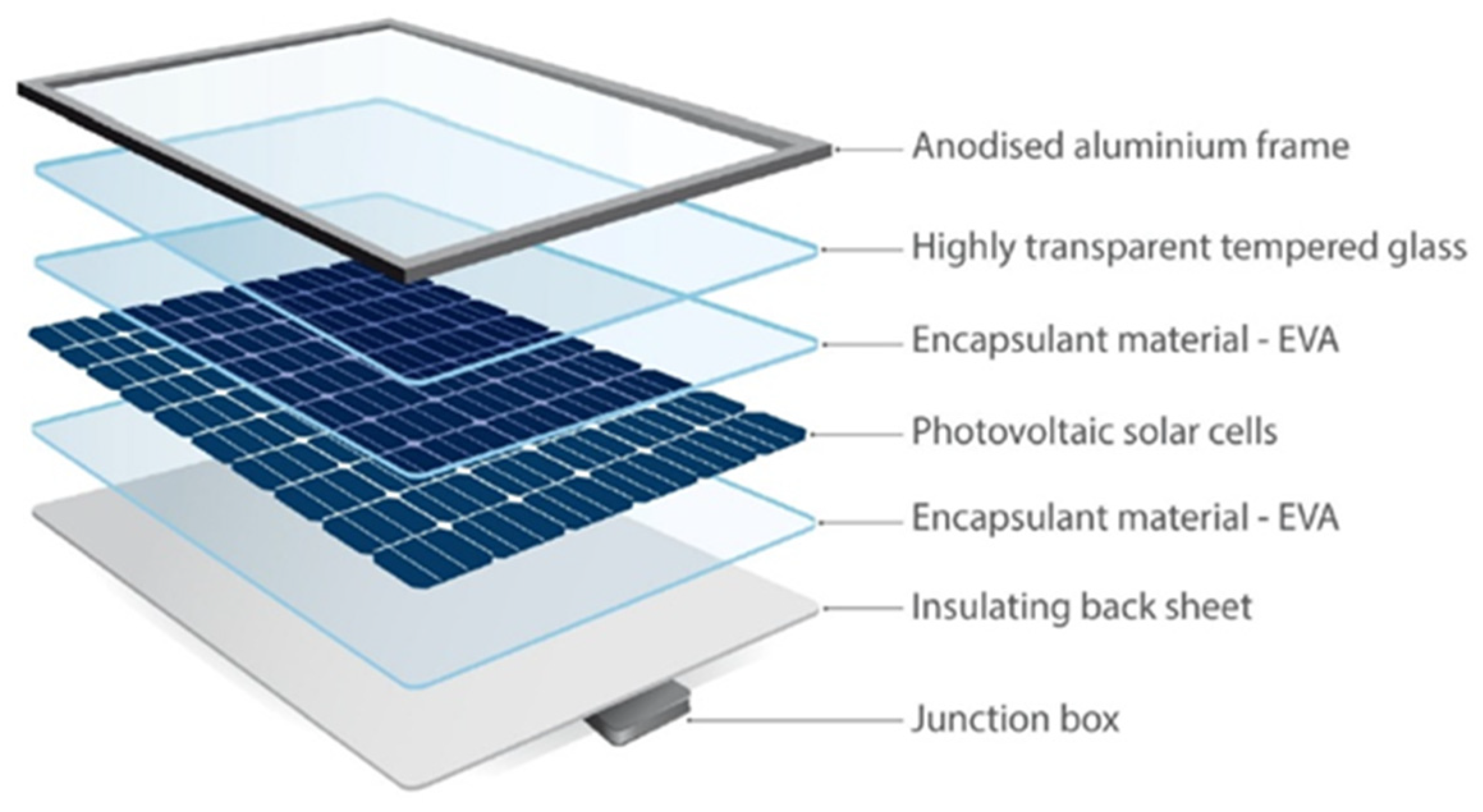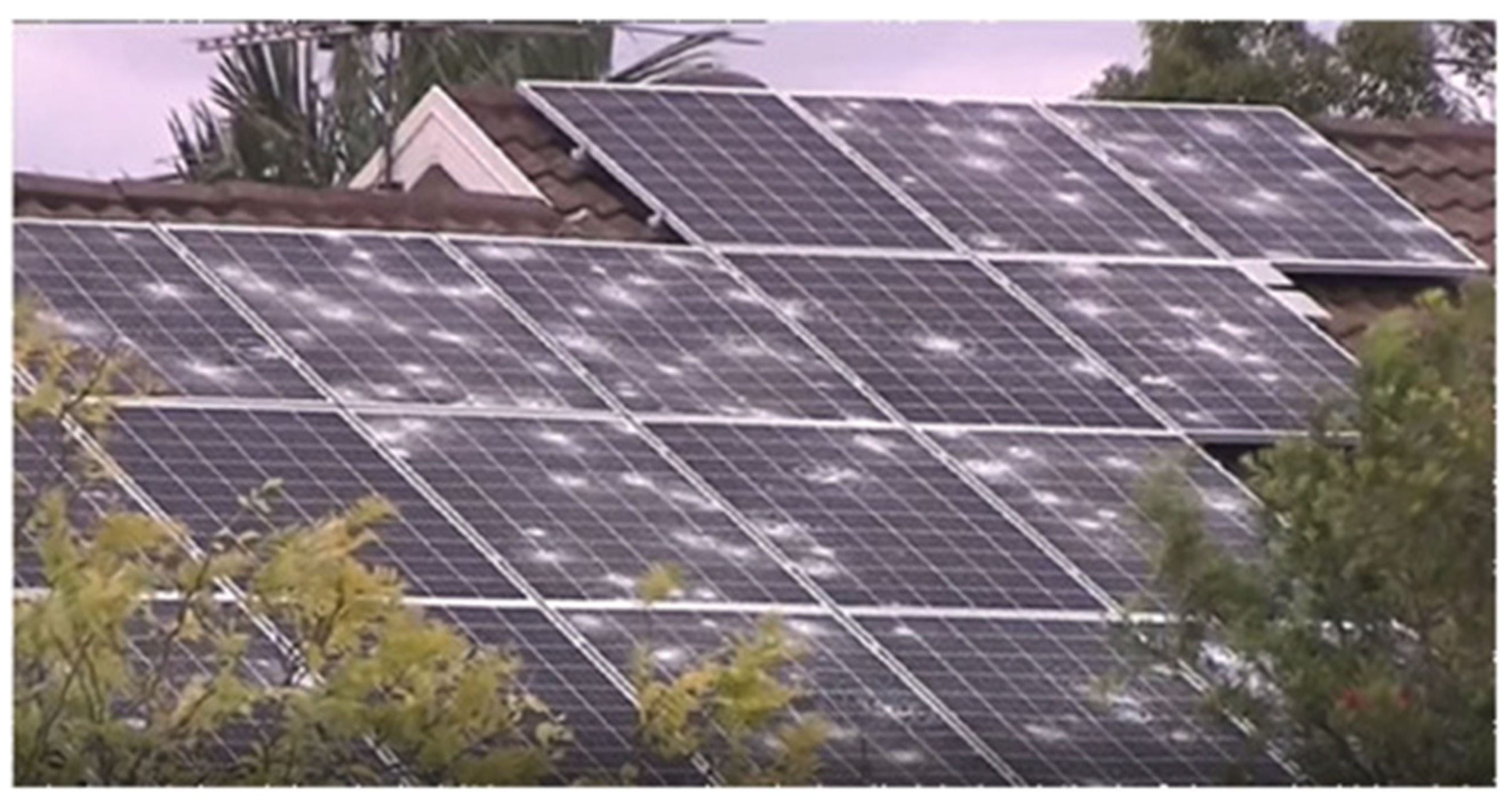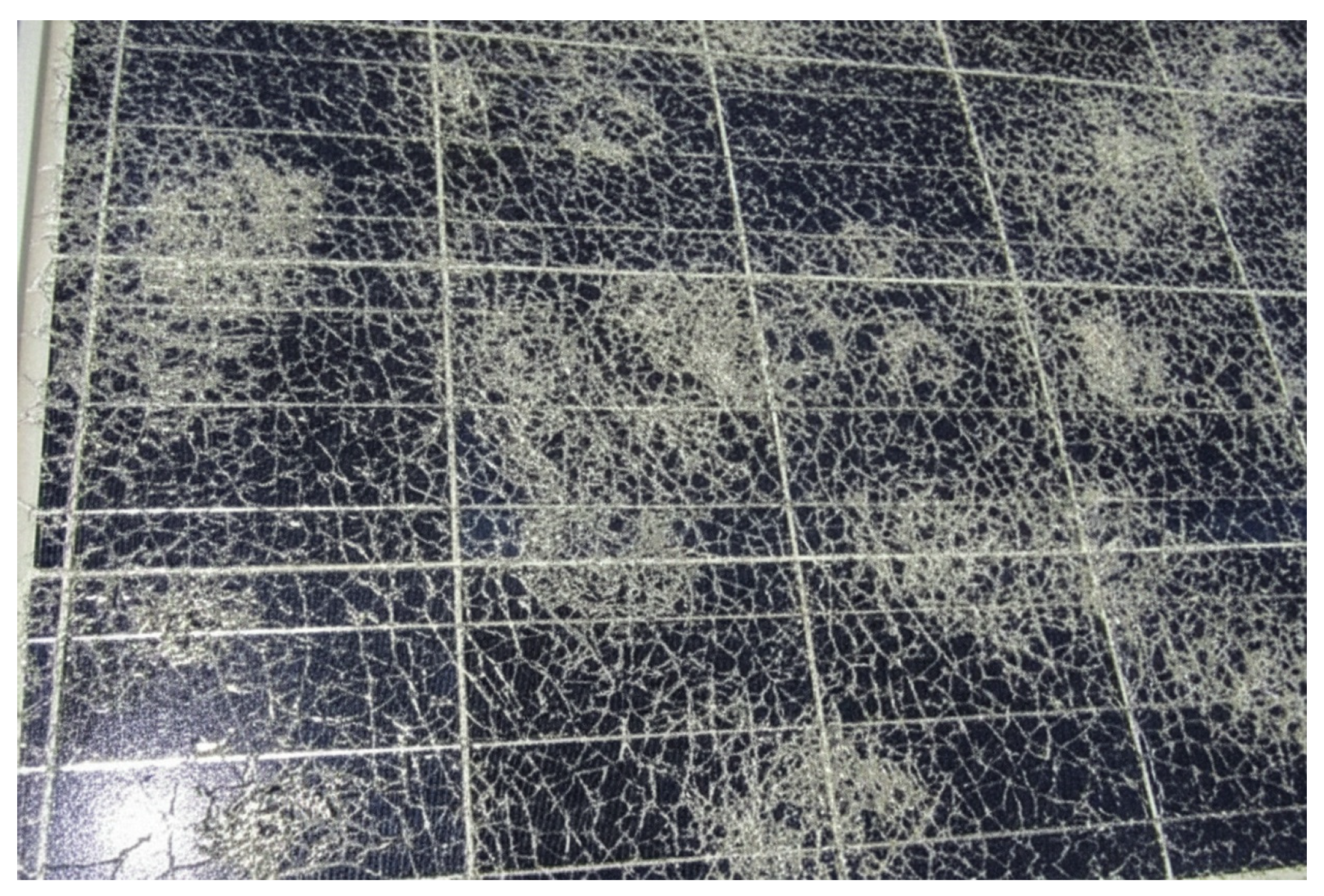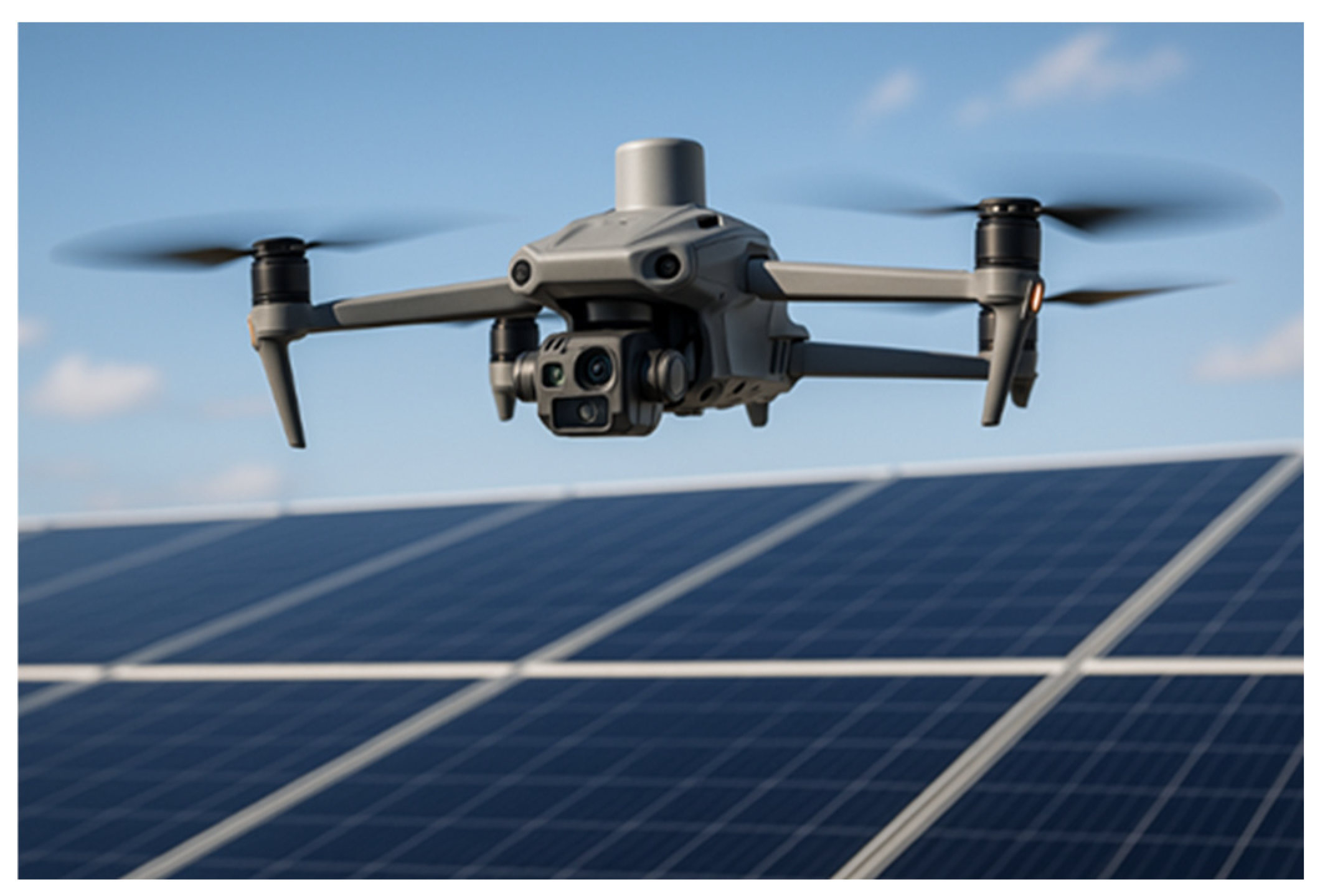Hailstorm Impact on Photovoltaic Modules: Damage Mechanisms, Testing Standards, and Diagnostic Techniques
Abstract
1. Introduction
2. Materials and Methods
- Review of standardised test protocols such as IEC 61215, IEC 61646, IEC 61730, and ASTM 1038-10 for hail resistance, including impact velocities, hailstone sizes, and pass/fail criteria.
- Testing of mechanical and material reports focussing on module components, including glass properties, encapsulation materials, solar cells, backsheets, and frames.
- Evaluation of numerical simulation methods (finite element methods, smoothed particle hydrodynamics, arbitrary Lagrange-Euler approaches) used for hail impact modelling and damage propagation prediction.
- Comparison of empirical data from laboratory impact tests and real hailstorms to validate the simulation results.
3. Results
3.1. PV Module Structure
3.2. Standards for Testing the Resistance of PV Modules to Hailstorms
3.3. Numerical Simulations of Hail Impacts on PV Modules
3.3.1. Numerical Simulation Methods
3.3.2. Hail and PV Module Modelling
3.3.3. Contact and Interaction Models
3.3.4. Validation and Limitations
- High sensitivity to input parameters and model assumptions;
- Idealization of hail shape and velocity, without fully modelling realistic stochastic conditions;
- Limited applicability in long-term monitoring of latent damage and degradation;
- Computational complexity, especially for SPH and ALE/CEL methods.
3.4. Impact of Hail on PV Modules
3.4.1. Damage Mechanism
3.4.2. Types of Damage
3.4.3. The Influence of PV Module Design and Materials
3.4.4. Case Study Examples
3.5. Damage Detection Methods
3.6. Economic and Insurance Aspects of the Effects of Hail on PV Modules
- Direct repair and replacement costs: The main financial burden is the cost of replacing or maintaining damaged modules, replacing busbars and the associated labour. The damage can amount to several million euros for large photovoltaic systems.
- Loss of energy production: Damaged modules and their partial or complete shutdown lead to a reduction in total annual income and thus to an extension of the return on investment (ROI).
- Invisible and latent damage: Even if they are not immediately recognised, subsequent performance losses and increased operating costs can significantly reduce the economic results of the project.
- Integration of inspection technologies and insurance: Insurers favour owners/projects that use automated damage detection (e.g., via drones, AI inspection) and prevention methods (hail dams, advanced materials), offering better terms and lower premiums to those who use them.
- Incorporating the results of numerical simulations and real measurements into insurance calculations: Software that predicts the areas with the highest risk based on simulations, geolocalisation and meteorological data will become a mandatory tool for both insurance quotes and investment decisions.
- Performance-based insurance and new standards: There are more and more policies on the market that cover power outages due to latent damage, subject to regular inspections and validation of module condition after each major storm.
4. Discussion
4.1. Hail Impact on Performance and Long-Term Reliability
4.2. Comparison of PV Module Technologies and Designs
4.3. Recommendations for Improving the Resistance of PV Modules to Hail
4.4. The Impact of Glass Thickness on Cost-Effectiveness
5. Conclusions
- the use of thicker and higher quality glass;
- the use of more resistant materials and multi-layered structures;
- the integration of simulations into the design and certification process;
- carrying out regular inspections after storms using advanced diagnostic techniques.
Author Contributions
Funding
Institutional Review Board Statement
Informed Consent Statement
Data Availability Statement
Acknowledgments
Conflicts of Interest
Abbreviations
| AI | Artificial Intelligence |
| ALE | Arbitrary Lagrangian Eulerian |
| ASTM | American Society for Testing and Materials |
| BC | Back Contact |
| BIPV | Building-integrated photovoltaic systems |
| CdTe | Cadmium Telluride |
| CEL | Coupled Eulerian-Lagrangian |
| EL | Electroluminescence |
| EVA | Ethylene Vinyl Acetate |
| FEA | Finite element analysis |
| HJT | Heterojunction |
| HRC | Hail Resistance Curve |
| IEA | International Energy Agency |
| IEC | International Electrotechnical Commission |
| ML | Machine Learning |
| PML | Probable Maximum Loss |
| PV | Photovoltaic |
| R-CNN | Region-based Convolutional Neural Networks |
| ROI | Return on Investment |
| SPH | Smoothed Particle Hydrodynamics |
| TG | Thermography |
| TOPCon | Tunnel oxide passivated contact cells |
| UV-F | Ultraviolet-Fluorescence |
| VKF | Vereinigung Kantonaler Feuerversicherungen (Association of Cantonal Fire Insurers) |
| YOLOv3 | (You Only Look Once, Version 3) is a real-time object detection algorithm that identifies specific objects in videos, live feeds, or images. |
References
- Bošnjaković, M.; Galović, M.; Kuprešak, J.; Bošnjaković, T. The End of Life of PV Systems: Is Europe Ready for It? Sustainability 2023, 15, 16466. [Google Scholar] [CrossRef]
- Nicoletto, M.; Panizzon, D.; Caria, A.; Trivellin, N.; de Santi, C.; Buffolo, M.; Meneghesso, G.; Zanoni, E.; Meneghini, M. Hail Damage Investigation in Heterojunction Silicon Photovoltaic Modules: A Real-World Case Study. IEEE J. Photovolt. 2025, 15, 478–483. [Google Scholar] [CrossRef]
- Bošnjaković, M.; Stojkov, M.; Katinić, M.; Lacković, I. Effects of Extreme Weather Conditions on PV Systems. Sustainability 2023, 15, 16044. [Google Scholar] [CrossRef]
- Botzena, W.J.W.; Bouwera, L.M.; van den Bergh, J.C.J.M. Climate change and hailstorm damage: Empirical evidence and implications for agriculture and insurance. Resour. Energy Econ. 2010, 32, 341–362. [Google Scholar] [CrossRef]
- Pucik, T. Hailstorms of 2024. European Severe Storms Laboratory 2025. Available online: https://www.essl.org/cms/hailstorms-of-2024/ (accessed on 18 August 2025).
- Büşra Artaş, S.; Kocaman, E.; Hüseyin Bilgiç, H.; Tutumlu, H.; Yağlı, H.; Yumrutaş, R. Why PV panels must be recycled at the end of their economic life span? A case study on recycling together with the global situation. Process Saf. Environ. Prot. 2023, 174, 63–78. [Google Scholar] [CrossRef]
- Peters, I.M.; Hauch, J.A.; Brabec, C.J. The role of innovation for economy and sustainability of photovoltaic modules. iScience 2022, 25, 105208. [Google Scholar] [CrossRef] [PubMed]
- Ali, H.B.; Kamran, M.A.; Gul, R.; Yasir, M.; Alabdullah, F.T.; Usman, C.; Tariq, A. Mechanical integrity of photovoltaic panels under hailstorms: Mono vs. poly-crystalline comparison. Heliyon 2024, 10, e25865. [Google Scholar] [CrossRef]
- Aghaei, M.; Fairbrother, A.; Gok, A.; Ahmad, S.; Kazim, S.; Lobato, K.; Oreski, G.; Reinders, A.; Schmitz, J.; Theelen, M.; et al. Review of degradation and failure phenomena in photovoltaic modules. Renew. Sustain. Energy Rev. 2022, 159, 112160. [Google Scholar] [CrossRef]
- Akram, M.W.; Li, G.; Jin, Y.; Chen, X. Failures of Photovoltaic modules and their Detection: A Review. Appl. Energy 2022, 313, 118822. [Google Scholar] [CrossRef]
- Bošnjaković, M.; Santa, R. Strategic Assessment of Building-Integrated Photovoltaics Adoption: A Combined SWOT-AHP Approach. Energies 2025, 18, 4221. [Google Scholar] [CrossRef]
- Cadoni, E.; Forni, D.; Dotta, M.; Bellenda, G.; Caccivio, M. Advanced characterisation of photovoltaics for hail resistance. Mater. Lett. 2024, 354, 135371. [Google Scholar] [CrossRef]
- Chakraborty, S.; Haldkar, A.; Manoj Kumar, N. Analysis of the hail impacts on the performance of commercially available photovoltaic modules of varying front glass thickness. Renew. Energy 2022, 203, 345–356. [Google Scholar] [CrossRef]
- Gupta, V.; Sharma, M.; Pachauri, R.; Dinesh Babu, K.N. Impact of hailstorm on the performance of PV module: A review. Energy Sources A: Recovery Util. Environ. Eff. 2019, 44, 1923–1944. [Google Scholar]
- Xie, Q. Numerical Study of the Hail Impact on PV Panel by Specific Constitutive Models. Int. J. Eng. Sci. Appl. 2023, 7, 1–7. [Google Scholar]
- Macdonald, J.R.; Stack, M.M. Some Thoughts on Modelling Hail Impact on Surfaces. J. Bio-Tribo-Corros. 2021, 7, 37. [Google Scholar] [CrossRef]
- IEC 61215-2:2021; Terrestrial Photovoltaic (PV) Modules-Design Qualification and Type Approval-Part 2: Test Procedures. International Electrotechnical Commission: Geneva, Switzerland, 2021.
- IEC 61464:2008; Thin-Film Terrestrial Photovoltaic (PV) Modules-Design Qualification and Type Approval. International Electrotechnical Commission: Geneva, Switzerland, 2008.
- IEC 61730-1:2023; Photovoltaic (PV) Module Safety Qualification—Part 1: Requirements for Construction. International Electrotechnical Commission: Geneva, Switzerland, 2023.
- ASTM E1038-10; Standard Test Method Determining Resistance of Photovoltaic Modules to Hail by Impact with Propelled Ice Balls. ASTM International: West Conshohocken, PA, USA, 2019.
- Muehleisen, W.; Eder, G.; Voronko, Y.; Spielberger, M.; Sonnleitner, H.; Knoebl, K.; Ebner, R.; Ujvari, G.; Hirschl, C. Outdoor detection and visualization of hailstorm damages of photovoltaic plants. Renew. Energy 2018, 118, 138–145. [Google Scholar] [CrossRef]
- Gabor, A.; Knodle, P.J.; Covino, M.; Fioresi, J.; Colvin, D.; Davis, K. Electroluminescence Analysis and Grading of Hail Damaged Solar Panels. IEEE J. Photovolt. 2022, 12, 1308–1313. [Google Scholar] [CrossRef]
- Buerhopa, C.; Schlegela, D.; Niessb, M.; Vodermayerb, C.; Weißmanna, R.; Brabec, C.J. Reliability of IR-imaging of PV-plants under operating conditions. Sol. Energy Mater. Sol. Cells 2012, 107, 154–164. [Google Scholar] [CrossRef]
- Morlier, A.; Siebert, M.; Kunze, I.; Mathiak, G.; Köntges, M. Detecting Photovoltaic Module Failures in the Field During aytime with Ultraviolet Fluorescence Module Inspection. IEEE J. Photovolt. 2017, 7, 1710–1716. [Google Scholar] [CrossRef]
- Rödera, B.; Ermilova, E.A.; Philippb, D.; Köhlb, M. Observation of polymer degradation processes in photovoltaic modules via luminescence detection. In Proceedings of the SPIE, Volume 7048, Reliability of Photovoltaic Cells, Modules, Components, and Systems, San Diego, CA, USA, 11–13 August 2008. [Google Scholar]
- Perry, K.; Jordan, D.C.; Nguyen, Q. Assessing the Impacts of Extreme Weather Events on Photovoltaic Installations using Remote Sensing Imagery. Prog. Photovolt.: Res. Appl. 2025, 3, 1012–1023. [Google Scholar] [CrossRef]
- Forni, D.; Caccivio, M.; Chudy, D.; Cadoni, E. An experimental investigation of ice ball impact behaviour to improve PV panel hailstone safety. Int. J. Impact Eng. 2025, 202, 105315. [Google Scholar] [CrossRef]
- Dai, Y.; Wang, W.; Xu, Y.; Li, Y.; Liu, T. Experimental study on the influence of turbulence on hail impacts. Sci. Rep. 2024, 14, 18317. [Google Scholar] [CrossRef]
- Johnston, S.; Terwilliger, K.; Wai, R.; Kern, D.; Jordan, D. Photovoltaic Module Performance for Six Years After Hail Damage. In Proceedings of the IEEE 52nd Photovoltaic Specialist Conference (PVSC), Seattle, WA, USA, 9–14 June 2024; pp. 270–273. [Google Scholar]
- Budiman, A.S.; Sahay, R.; Agarwal, K.; Fajarna, R.; Gunawan, F.E.; Baji, A.; Raghavan, N. Modeling Impact Mechanics of 3D Helicoidally Architected Polymer Composites Enabled by Additive Manufacturing for Lightweight Silicon Photovoltaics Technology. Polymers 2022, 14, 1228. [Google Scholar] [CrossRef] [PubMed]
- Bošnjaković, M. Advance of Sustainable Energy Materials: Technology Trends for Silicon-Based Photovoltaic Cells. Sustainability 2024, 16, 7962. [Google Scholar] [CrossRef]
- SIA 261:2020; Effects on Structures, Ref. no. 505261:2020. Swiss Engineer and Architects Association: Zurich, Switzerland, 2020.
- Janda, M.; Jandová, K. Simulation of the Influence of Hail Mechanical Action on Photovoltaic Panels. ECS Trans. 2015, 70, 239–243. [Google Scholar] [CrossRef]
- Makarskas, V.; Jurevičius, M.; Zakis, J.; Kilikevičius, A.; Borodinas, S. Simulation Study of Hail Impact on Photovoltaic Modules. In Proceedings of the IEEE 7th IEEE Workshop on Advances in Information, Electronic and Electrical Engineering (AIEEE) 2019, Liepaja, Latvia, 15–16 November 2019; pp. 1–4. [Google Scholar]
- Matos, N.; Gomes, M.; Infante, V. Numerical modelling of soft body impacts: A review. Eng. Fail. Anal. 2023, 153, 107595. [Google Scholar] [CrossRef]
- Ivančević, D.; Badurina Žakan, I.; Smojver, I. Numerical Methodology for Aerostructures Hail Impact Damage Predictio. In IOP Conference Series: Materials Science and Engineering, Proceedings of the 10th EASN International Conference on Innovation in Aviation & Space to the Satisfaction of the European Citizens (10th EASN 2020), Salerno, Italy, 2–5 September 2020; IOP Publishing Ltd.: Bristol, UK, 2021; Volume 1024. [Google Scholar]
- Anghileri, M.; Castelletti, L.; Invernizzi, F.; Mascheroni, M. A survey of numerical models for hail impact analysis using explicit finite element codes. Int. J. Impact Eng. 2005, 31, 929–944. [Google Scholar] [CrossRef]
- Kim, H.; Kedward, K.T. Modeling hail ice impacts and predicting impact damage initiation in composite structures. AIAA J. 2000, 38, 1278–1288. [Google Scholar] [CrossRef]
- Tippmann, J.D.; Kim, H.; Rhymer, J.D. Experimentally validated strain rate dependent material model for spherical ice impact simulation. Int. J. Impact Eng. 2013, 57, 43–54. [Google Scholar] [CrossRef]
- Carney, K.S.; Benson, D.J.; DuBois, P.; Lee, R. A phenomenological high strain rate model with failure for ice. Int. J. Solids Struct. 2006, 43, 7820–7839. [Google Scholar] [CrossRef]
- Sain, T.; Narasimhan, R. Constitutive modeling of ice in the high strain rate regime. Int. J. Solids Struct. 2011, 48, 817–827. [Google Scholar] [CrossRef]
- Pernas-Sanchez, J.; Pedroche, D.A.; Varas, D.; López-Puente, J.; Zaera, R. Numerical modeling of ice behavior under high velocity impacts. Int. J. Solids Struct. 2012, 49, 1919–1927. [Google Scholar] [CrossRef]
- Hail Resiliency Curve Test for PV Modules. Available online: https://www.vde.com/resource/blob/2398924/f2223c1fd470bd41614ca5de68b4b56f/hcr-datasheet-data.pdf (accessed on 18 August 2025).
- Rana, Z.; Zamora, P.P.; Cobos-Murcia, J.A.; Soliz, A.; Soler, D.; Galleguillos Madrid, F.M. Solar Panel Corrosion: A Review. Int. J. Mol. Sci. 2025, 26, 5960. [Google Scholar] [CrossRef]
- Al Mahdi, H.; Leahy, P.G.; Alghoul, M.; Morrison, A.P. A Review of Photovoltaic Module Failure and Degradation Mechanisms: Causes and Detection Technique. Solar 2024, 4, 43–82. [Google Scholar] [CrossRef]
- Wu, D.; Wessel, P.; Zhu, J.; Montiel-Chicharro, D.; Betts, T.R.; Mordvinkin, A.; Gottschalg, R. Influence of Lamination Conditions of EVA Encapsulation on Photovoltaic Module Durability. Materials 2023, 16, 6945. [Google Scholar] [CrossRef]
- DiGregorio, J.S.; Braid, J.; Shimizu, M.A.; Hartley, J.Y. Laboratory Hail Damage of Photovoltaic Modules: Electroluminescence and High-speed Digital Image Correlation Analysis. In Proceedings of the IEEE 52nd Photovoltaic Specialist Conference (PVSC), Seattle, WA, USA, 9–14 June 2024; pp. 1625–1628. [Google Scholar]
- Kim, J.; Rabelo, M.; Padi, S.P.; Yousuf, H.; Cho, E.C.; Yi, J. A Review of the Degradation of Photovoltaic Modules for Life Expectancy. Energies 2021, 14, 4278. [Google Scholar] [CrossRef]
- Tas, M.P.M.; van Sark, W.G.J.H.M. Experimental repair technique for glass defects of glass-glass photovoltaic modules—A techno-economic analysis. Sol. Energ. Mat. Sol. C. 2023, 257, 112397. [Google Scholar] [CrossRef]
- van Dyk, E.E.; Chamel, J.B.; Gxasheka, A.R. Investigation of delamination in an edge-defined film-fed growth photovoltaic module. Sol. Energ. Mat. Sol. C. 2005, 88, 403–411. [Google Scholar] [CrossRef]
- From Random to Repeatable: Inside the Hail Stress Sequence for PVEL’s PV Module Product Qualification Program. Available online: https://www.pvel.com/wp-content/uploads/PVEL_White-Paper_Hail-Stress-Sequence-for-PV-Modules.pdf (accessed on 18 August 2025).
- Analysing Hailstorm a After Damage Panel. Available online: https://knowledge-center.solaredge.com/sites/kc/files/solaredge_case_study_hailstorm_damage_netherlands_eng.pdf (accessed on 18 August 2025).
- Protecting Solar Panels from Hail—The Thicker the Glass, the Better. Available online: https://ceramics.org/ceramic-tech-today/protecting-solar-panels-from-hail-the-thicker-the-glass-the-better/ (accessed on 18 August 2025).
- Abdelsattar, M.; Abdelmoety, A.; Emad-Eldeen, A. A Review on Detection of Solar PV Panels Failures Using Image Processing Techniques. In Proceedings of the 24th International Middle East Power System Conference (MEPCON), Mansoura, Egypt, 19–21 December 2023; pp. 1–6. [Google Scholar]
- Jiang, Z.; Du, G.; Song, Z.; Cao, S.; Wang, G.; Ma, L. Electromagnetic Method for Detecting Black Piece on Monocrystalline Silicon Photovoltaic Panels. IEEE Trans. Instrum. Meas. 2024, 73, 3508108. [Google Scholar] [CrossRef]
- Polymeropoulos, I.; Bezyrgiannidis, S.; Vrochidou, E.; Papakostas, G.A. Enhancing Solar Plant Efficiency: A Review of Vision-Based Monitoring and Fault Detection Techniques. Technologies 2024, 12, 175. [Google Scholar] [CrossRef]
- Dhimish, M.; Tyrrell, A.M. Optical Filter Design for Daylight Outdoor Electroluminescence Imaging of PV Modules. Photonics 2024, 11, 63. [Google Scholar] [CrossRef]
- Liu, Y.; Wu, Y. Fault diagnosis of photovoltaic modules: A review. Solar Energy 2025, 293, 113489. [Google Scholar] [CrossRef]
- Bressan, M.; El Basri, Y.; Galeano, A.G.; Alonso, C. A shadow fault detection method based on the standard error analysis of I-V curves. Renew. Energy 2016, 99, 1181–1190. [Google Scholar] [CrossRef]
- Thakfan, A.; Salamah, Y.B. Artificial-Intelligence-Based Detection of Defects and Faults in Photovoltaic Systems: A Survey. Energies 2024, 17, 4807. [Google Scholar] [CrossRef]
- Di Tommaso, A.; Betti, A.; Fontanelli, G.; Michelozzi, B. A Multi-Stage model based on YOLOv3 for defect detection in PV panels based on IR and Visible Imaging by Unmanned Aerial Vehicle. Renew. Energy 2021, 193, 941–962. [Google Scholar] [CrossRef]
- Li, L.; Wang, Z.; Zhang, T. GBH-YOLOv5: Ghost Convolution with Bottleneck CSP and Tiny Target Prediction Head Incorporating YOLOv5 for PV Panel Defect Detection. Electronics 2023, 12, 561. [Google Scholar] [CrossRef]
- Lei, Y.; Wang, X.; An, A.; Guan, H. Deeplab-YOLO: A method for detecting hot-spot defects in infrared image PV panels by combining segmentation and detection. J. Real-Time Image Process. 2024, 21, 52. [Google Scholar] [CrossRef]
- Peng, T.; Wen, F. Photovoltaic Panel Fault Detection Based on Improved Mask R-CNN. In Proceedings of the IEEE International Conference on Control, Electronics and Computer Technology (ICCECT), Jilin, China, 28–30 April 2023; pp. 1187–1191. [Google Scholar]
- Wen, M.; Peng, C. Research on Hot Spot Detection of Photovoltaic Panels Based on Image Processing. In Proceedings of the 3rd International Conference on Robotics, Artificial Intelligence and Intelligent Control (RAIIC), Mianyang, China, 5–7 July 2024; pp. 411–414. [Google Scholar]
- Ghahremani, A.; Adams, S.D.; Norton, M.; Khoo, S.Y.; Kouzani, A.Z. Detecting Defects in Solar Panels Using the YOLO v10 and v11 Algorithms. Electronics 2025, 14, 344. [Google Scholar] [CrossRef]
- Bošnjaković, M.; Martinović, M.; Đokić, K. Application of Artificial Intelligence in Wind Power Systems. Appl. Sci. 2025, 15, 2443. [Google Scholar] [CrossRef]
- Michail, A.; Livera, A.; Tziolis, G.; Candas, J.L.C.; Fernandez, A.; Yudego, E.A.; Martínez, D.F.; Antonopoulos, A.; Trip-olitsiotis, A.; Partsinevelos, P.; et al. A comprehensive review of unmanned aerial vehicle-based approaches to support photovoltaic plant diagnosis. Heliyon 2024, 10, e23983. [Google Scholar] [CrossRef]
- Yang, C.; Sun, F.; Zou, Y.; Lv, Z.; Xue, L.; Jiang, C.; Liu, S.; Zhao, B.; Cui, H. A Survey of Photovoltaic Panel Overlay and Fault Detection Methods. Energies 2024, 17, 837. [Google Scholar] [CrossRef]
- Lin, J.H.; Wu, Y.K. Simulation and Fault Diagnosis Using Current-Voltage Characteristics of Photovoltaic Systems—A Case Study. Eng. Proc. 2025, 92, 79. [Google Scholar]
- Yi, Z.; Etemadi, A. Fault Detection for Photovoltaic Systems Based on Multi-Resolution Signal Decomposition and Fuzzy Inference Systems. IEEE Trans. Smart Grid 2017, 8, 1274–1283. [Google Scholar] [CrossRef]
- Winston, D.P.; Murugan, M.S.; Elavarasan, R.M.; Pugazhendhi, R.; Singh, O.J.; Murugesan, P.; Gurudhachanamoorthy, M.; Hossain, E. Solar PV’s Micro Crack and Hotspots Detection Technique Using NN and SVM. IEEE Access 2021, 9, 127259–127269. [Google Scholar] [CrossRef]
- Balakrishnan, D.; Raja, J.; Rajagopal, M.; Sudhakar, K.; Janani, K. An IoT-Based System for Fault Detection and Diagnosis in Solar PV Panels. E3S Web Conf. 2023, 387, 05009. [Google Scholar]
- Sakhria, B.; Hamaidi, B.; Djemana, M.; Benhassine, N. Harnessing neural networks for precise damage localization in photovoltaic solar via impedance-based structural health monitoring. Electr. Eng. 2024, 107, 3229–3245. [Google Scholar] [CrossRef]
- Orme, G.J.; Venturini, M. Property risk assessment for power plants: Methodology, validation and application. Energy 2011, 36, 3189–3203. [Google Scholar] [CrossRef]
- Best Practices for Hail Stow of Single-Axis Tracker-Mounted Solar Projects. Available online: https://www.vde.com/en/vde-americas/newsroom/240221-hail-stow-tech-memo (accessed on 18 August 2025).
- Martins, A.C.; Chapuis, V.; Virtuani, A.; Perret-Aebi, L.E.; Ballif, C. Hail Resistance of Composite-Based Glass-Free Lightweight Modules for Building. In Proceedings of the 33rd European Photovoltaic Solar Energy Conference and Exhibition, Amsterdam, The Netherlands, 25–29 September 2017; pp. 2604–2608. [Google Scholar]
- Martins, A.C.; Chapuis, V.; Virtuani, A.; Ballif, C. Robust Glass-Free Lightweight Photovoltaic Modules with Improved Resistance to Mechanical Loads and Impact. IEEE J. Photovolt. 2018, 9, 245–251. [Google Scholar] [CrossRef]
- Budiman, A.S.; Sahay, R.; Agarwal, K.; Illya, G.; Widjaja, R.G.; Baji, A.; Raghavan, N. Impact-Resistant and Tough 3D Helicoidally Architected Polymer Composites Enabling Next-Generation Lightweight Silicon Photovoltaics Module Design and Technology. Polymers 2021, 13, 3315. [Google Scholar] [CrossRef]
- Yang, H.I.; Naveen, K.R.; Cho, S.M.; Kim, J.Y.; Jung, Y.H.; Kwon, J.H. Systematic investigation on polymer layer selection for flexible thin film encapsulation. Org. Electron. 2023, 115, 106761. [Google Scholar] [CrossRef]
- Corrado, M.; Infuso, A.; Paggi, M. Simulated hail impacts on flexible photovoltaic laminates: Testing and modelling. Meccanica 2017, 52, 1425–1439. [Google Scholar] [CrossRef]
- Arslan, M.; Çunkas, M. An experimental study on determination of optimal tilt and orientation angles in photovoltaic systems. J. Eng. Res. 2024, in press.








| Method | Type of Damage | Advantages | Limitations | References |
|---|---|---|---|---|
| Visual inspection | Visible damage | Simple, inexpensive | Does not reveal micro-cracks | [21,45] |
| Thermography | Hot spots, fractures | Fast, suitable for large systems | Does not detect all faults | [2,23,54] |
| Electroluminescence (EL) | Micro-cracks, delamination | Very precise | Requires special equipment | [13,21,23,45,55,56,57] |
| Computer Vision (AI/ML) | All types | Automatic, high accuracy | Model training required | [61,62,63,64,65,66,67] |
| Analysis of I-V characteristics | Electrical faults | Real-time, remote monitoring | Limited localization | [69,70] |
| Fuzzy logic, neural networks | All types | Automatic diagnosis, high precision | Calibration required | [71,72,73,74] |
Disclaimer/Publisher’s Note: The statements, opinions and data contained in all publications are solely those of the individual author(s) and contributor(s) and not of MDPI and/or the editor(s). MDPI and/or the editor(s) disclaim responsibility for any injury to people or property resulting from any ideas, methods, instructions or products referred to in the content. |
© 2025 by the authors. Licensee MDPI, Basel, Switzerland. This article is an open access article distributed under the terms and conditions of the Creative Commons Attribution (CC BY) license (https://creativecommons.org/licenses/by/4.0/).
Share and Cite
Katinić, M.; Bošnjaković, M. Hailstorm Impact on Photovoltaic Modules: Damage Mechanisms, Testing Standards, and Diagnostic Techniques. Technologies 2025, 13, 473. https://doi.org/10.3390/technologies13100473
Katinić M, Bošnjaković M. Hailstorm Impact on Photovoltaic Modules: Damage Mechanisms, Testing Standards, and Diagnostic Techniques. Technologies. 2025; 13(10):473. https://doi.org/10.3390/technologies13100473
Chicago/Turabian StyleKatinić, Marko, and Mladen Bošnjaković. 2025. "Hailstorm Impact on Photovoltaic Modules: Damage Mechanisms, Testing Standards, and Diagnostic Techniques" Technologies 13, no. 10: 473. https://doi.org/10.3390/technologies13100473
APA StyleKatinić, M., & Bošnjaković, M. (2025). Hailstorm Impact on Photovoltaic Modules: Damage Mechanisms, Testing Standards, and Diagnostic Techniques. Technologies, 13(10), 473. https://doi.org/10.3390/technologies13100473










